| Listing 1 - 5 of 5 |
Sort by
|
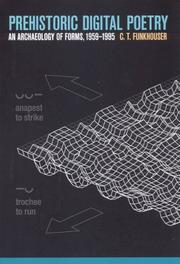
ISBN: 0817380876 9780817380878 9780817315627 0817315624 9780817354220 0817354220 Year: 2007 Publisher: Tuscaloosa : University of Alabama Press,
Abstract | Keywords | Export | Availability | Bookmark
 Loading...
Loading...Choose an application
- Reference Manager
- EndNote
- RefWorks (Direct export to RefWorks)
A singular and major historical view of the birth of electronic poetry. For the last five decades, poets have had a vibrant relationship with computers and digital technology. This book is a documentary study and analytic history of digital poetry that highlights its major practitioners and the ways that they have used technology to foster a new aesthetic. Focusing primarily on programs and experiments produced before the emergence of the World Wide Web in the mid-1990s, C. T. Funkhouser analyzes numerous landmark works of digital poetry to illustrate that the founda
Hypertext systems. --- Interactive multimedia. --- Computer poetry --- Hypertext --- Interactive multimedia --- Hypermedia systems --- Interactive media --- Computer software --- Poetics --- Computational linguistics --- Poetry --- Technique. --- History and criticism. --- Computer poetry.
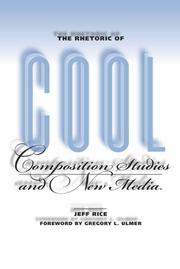
ISBN: 0809387603 9780809387601 1299828604 9781299828605 9780809327522 080932752X Year: 2007 Publisher: Carbondale : Southern Illinois University Press,
Abstract | Keywords | Export | Availability | Bookmark
 Loading...
Loading...Choose an application
- Reference Manager
- EndNote
- RefWorks (Direct export to RefWorks)
The Rhetoric of Cool: Composition Studies and New Media offers a historical critique of composition studies' rebirth narrative, using that critique to propose a new rhetoric for new media work. Author Jeff Rice returns to critical moments during the rebirth of composition studies when the discipline chose not to emphasize technology, cultural studies, and visual writing, which are now fundamental to composition studies. Rice redefines these moments in order to invent a new electronic practice. The Rhetoric of Cool addresses the disciplinary claim that com
Interactive multimedia. --- Language and culture. --- Communication --- Cool (The English word) --- English language --- Culture and language --- Culture --- Hypermedia systems --- Interactive media --- Computer software --- Philosophy. --- Rhetoric --- Study and teaching. --- Computer-assisted instruction. --- Etymology --- Germanic languages
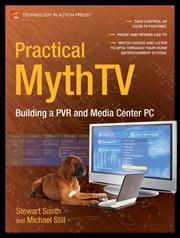
ISBN: 1281139157 9786611139155 1430203730 1590597796 Year: 2007 Publisher: Berkeley, Calif. : Apress,
Abstract | Keywords | Export | Availability | Bookmark
 Loading...
Loading...Choose an application
- Reference Manager
- EndNote
- RefWorks (Direct export to RefWorks)
MythTV is a powerful open source personal video recorder (PVR) application that runs on Linux. Developed for several years by volunteers, it offers a stable and extensible platform for automating all of the things you would expect from a PVR, and much more. Practical MythTV: Building a PVR and Media Center PC takes a project-based approach to implementing your own MythTV setup. You get to pick and choose the functionality you want to install for your PVR, and will learn the details of everything from selecting hardware to advanced customization. You will learn how to record your favorite television shows, store your DVDs for later playback, create a music library out of your CD collection, and even use your PVR for voiceover IP. Your PVR wouldn't be complete without a remote control or the ability to play back content to other TVs in your home. You'll learn how to do both of these things in this book. You'll even learn to how to utilize your Xbox as a remote front-end to play back content. Beyond these basics, you will learn advanced techniques like commercial detection and skipping, auto-expiring content, creating your own themes for MythTV, and utilizing plug-ins to do things like display weather conditions, RSS feeds, and photo slide shows.
Interactive multimedia. --- Interactive television. --- Multimedia systems. --- Home entertainment systems. --- MythTV. --- Myth TV --- Entertainment systems, Home --- Household electronics --- Computer-based multimedia information systems --- Multimedia computing --- Multimedia information systems --- Multimedia knowledge systems --- Information storage and retrieval systems --- Television --- Hypermedia systems --- Interactive media --- Computer software --- Information Technology --- Computer Science (Hardware & Networks) --- Computer input-output equipment. --- Software engineering. --- Hardware and Maker. --- Software Engineering/Programming and Operating Systems. --- Computer software engineering --- Engineering --- Computer hardware --- Computer I/O equipment --- Computers --- Electronic analog computers --- Electronic digital computers --- Hardware, Computer --- I/O equipment (Computers) --- Input equipment (Computers) --- Input-output equipment (Computers) --- Output equipment (Computers) --- Computer systems --- Input-output equipment
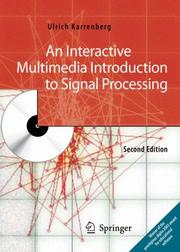
ISBN: 3540491562 354049152X Year: 2007 Publisher: Berlin, Heidelberg : Springer Berlin Heidelberg : Imprint: Springer,
Abstract | Keywords | Export | Availability | Bookmark
 Loading...
Loading...Choose an application
- Reference Manager
- EndNote
- RefWorks (Direct export to RefWorks)
A didactic concept is undertaken for microelectronics, computer technology and communication engineering, which deals with the visualization of signals and processes in addition to graphical programming of signal processing systems. Through the utilization of a professional and globally supported software for metrology and control engineering, DasyLab, useful applications can be developed, modified and optimized. Computer supported processing of real signals is made possible over the sound card and the parallel port. Over two hundred pre-programmed signal engineering systems and design transparencies are provided. Pictures also play a dominant rule in this book: there are numerous introduction-videos, one for every chapter, more than 250 high-quality pictures and - most important – all the "living" experiments and their results are visualized. With this learning system, readers can now make use of "equipment" and software, which was practically unaffordable for individuals in the past. What's more, here is a very new concept for learning Signal Processing, not only from the physically-based scientific fundamentals, but also from the didactic perspective, based on modern results of brain research.
Signal processing. --- Signal processing --- Interactive multimedia. --- Graphic methods. --- Hypermedia systems --- Interactive media --- Computer software --- Processing, Signal --- Information measurement --- Signal theory (Telecommunication) --- Systems engineering. --- Computer engineering. --- Circuits and Systems. --- Signal, Image and Speech Processing. --- Electrical Engineering. --- Computers --- Engineering systems --- System engineering --- Engineering --- Industrial engineering --- System analysis --- Design and construction --- Electronic circuits. --- Image processing. --- Speech processing systems. --- Electrical engineering. --- Electric engineering --- Computational linguistics --- Electronic systems --- Information theory --- Modulation theory --- Oral communication --- Speech --- Telecommunication --- Singing voice synthesizers --- Pictorial data processing --- Picture processing --- Processing, Image --- Imaging systems --- Optical data processing --- Electron-tube circuits --- Electric circuits --- Electron tubes --- Electronics
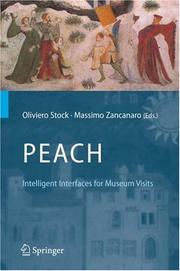
ISSN: 16112482 ISBN: 1280864753 9786610864751 3540687556 3540687548 3642088244 Year: 2007 Publisher: New York : Springer,
Abstract | Keywords | Export | Availability | Bookmark
 Loading...
Loading...Choose an application
- Reference Manager
- EndNote
- RefWorks (Direct export to RefWorks)
Personal Experience with Active Cultural Heritage, PEACH, is a large, interdisciplinary development project that explores the use of novel technologies for physical museum visits. Led by teams from ITC-irst, Trento and DFKI, Saarbrücken, the research is at the forefront of work on intelligent user interfaces, but also covers other areas of artificial intelligence, microsystems and human-computer interaction. This book is structured into 13 chapters, including reports on mobile guides, infrastructure and user modeling, the use of stationary devices, collaborative storytelling, 3D modelling, evaluation and usability, and future perspectives. The book editors and authors are leading experts on the underlying AI technologies and their application, and no other book has comparable technical insight and breadth. It represents a coherent survey of the relevant technologies and environment, and will be of benefit to AI researchers engaged with interface design, and practitioners in the area of cultural heritage support and marketing.
Culture --- Cultural heritage. --- Library science. --- Multimedia information systems. --- User interfaces (Computer systems). --- Artificial intelligence. --- Application software. --- Cultural and Media Studies. --- Cultural Heritage. --- User Interfaces and Human Computer Interaction. --- Multimedia Information Systems. --- Artificial Intelligence (incl. Robotics). --- Computer Appl. in Arts and Humanities. --- Library Science. --- Application computer programs --- Application computer software --- Applications software --- Apps (Computer software) --- Computer software --- AI (Artificial intelligence) --- Artificial thinking --- Electronic brains --- Intellectronics --- Intelligence, Artificial --- Intelligent machines --- Machine intelligence --- Thinking, Artificial --- Bionics --- Cognitive science --- Digital computer simulation --- Electronic data processing --- Logic machines --- Machine theory --- Self-organizing systems --- Simulation methods --- Fifth generation computers --- Neural computers --- Interfaces, User (Computer systems) --- Human-machine systems --- Human-computer interaction --- Computer-based multimedia information systems --- Multimedia computing --- Multimedia information systems --- Multimedia knowledge systems --- Information storage and retrieval systems --- Librarianship --- Library economy --- Bibliography --- Documentation --- Information science --- Cultural heritage --- Cultural patrimony --- Cultural resources --- Heritage property --- National heritage --- National patrimony --- National treasure --- Patrimony, Cultural --- Treasure, National --- Property --- World Heritage areas --- Cultural studies --- Study and teaching. --- Museum exhibits. --- Museum techniques. --- Interactive multimedia. --- Display techniques --- Displays, Museum --- Museum displays --- Museums --- Exhibitions --- Museum techniques --- Hypermedia systems --- Interactive media --- Museology --- Technique --- Computer science. --- Multimedia systems. --- Information systems. --- Artificial Intelligence. --- Informatics --- Science
| Listing 1 - 5 of 5 |
Sort by
|

 Search
Search Feedback
Feedback About UniCat
About UniCat  Help
Help News
News